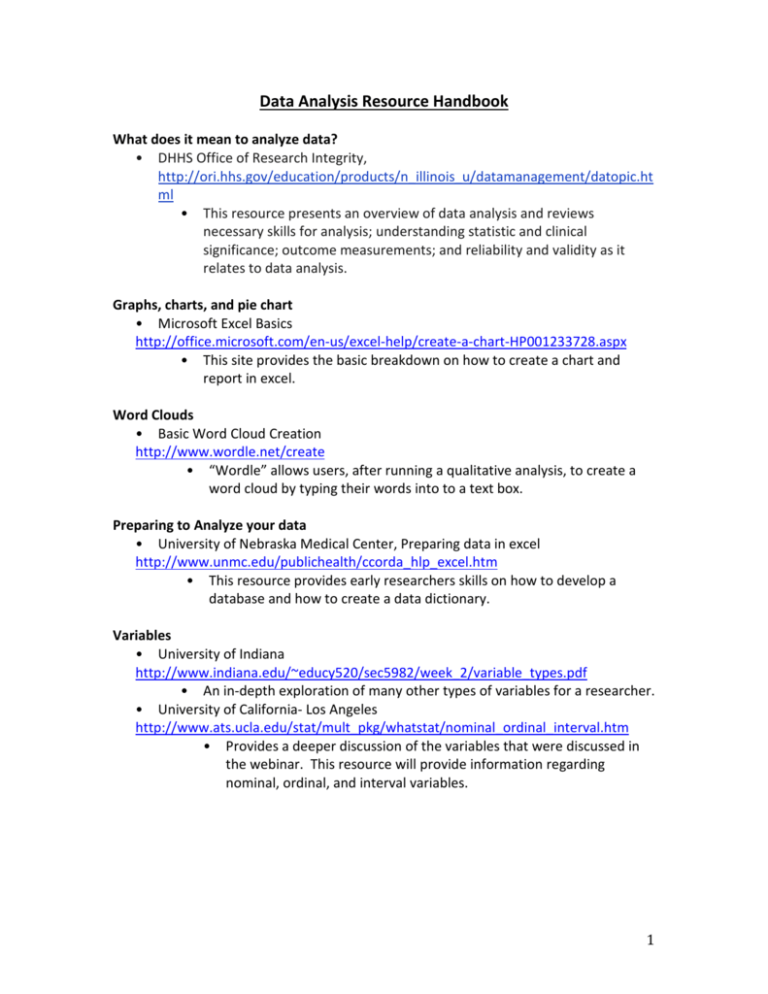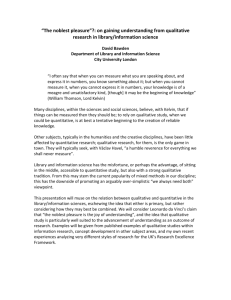Data Analysis Resource Handbook
advertisement

Data Analysis Resource Handbook What does it mean to analyze data? • DHHS Office of Research Integrity, http://ori.hhs.gov/education/products/n_illinois_u/datamanagement/datopic.ht ml • This resource presents an overview of data analysis and reviews necessary skills for analysis; understanding statistic and clinical significance; outcome measurements; and reliability and validity as it relates to data analysis. Graphs, charts, and pie chart • Microsoft Excel Basics http://office.microsoft.com/en-us/excel-help/create-a-chart-HP001233728.aspx • This site provides the basic breakdown on how to create a chart and report in excel. Word Clouds • Basic Word Cloud Creation http://www.wordle.net/create • “Wordle” allows users, after running a qualitative analysis, to create a word cloud by typing their words into to a text box. Preparing to Analyze your data • University of Nebraska Medical Center, Preparing data in excel http://www.unmc.edu/publichealth/ccorda_hlp_excel.htm • This resource provides early researchers skills on how to develop a database and how to create a data dictionary. Variables • University of Indiana http://www.indiana.edu/~educy520/sec5982/week_2/variable_types.pdf • An in-depth exploration of many other types of variables for a researcher. • University of California- Los Angeles http://www.ats.ucla.edu/stat/mult_pkg/whatstat/nominal_ordinal_interval.htm • Provides a deeper discussion of the variables that were discussed in the webinar. This resource will provide information regarding nominal, ordinal, and interval variables. 1 Independent versus Dependent Variable • National Center for Educational Statistics https://nces.ed.gov/nceskids/help/user_guide/graph/variables.asp • This resource provides a very basic look at the difference between an independent variable and dependent variable with examples. This resource, albeit very basic, provides great examples that will help the user understand the difference very clearly. How we analyze data • Oak Ridge Institute for Science and Education http://www.orau.gov/cdcynergy/soc2web/Content/phase05/phase05_step03_de eper_qualitative_and_quantitative.htm • This resource is a table that shows the difference between qualitative and quantitative research methods. Includes some limitations of both methods that will be discussed in later slides. Qualitative Data • RTI International http://www.rti.org/page.cfm/Qualitative_Analysis • This resource provides a much more in-depth explanation of what qualitative analysis is and how it can be used in the field. It also provides examples of current qualitative projects that are currently being conducted. • University of Southern California, TEAM LAB http://teamlab.usc.edu/Photovoice%20Literature%20Review%20(FINAL).pdf • This resource is a literature review of the community based participatory research project called, Photovoice. Photovoice is a qualitative research mechanism for personal and community change. • Sage Publications http://www.sagepub.com/upm-data/43454_10.pdf • This resource, which is a full chapter on qualitative analysis, shows the researcher how to conduct qualitative analysis in full with many details and examples. This resource can help a researcher from the early stages of looking at qualitative analysis to actually conducting and analyzing the research. • Learn Higher and MMU http://archive.learnhigher.ac.uk/analysethis/main/qualitative.html • This resource provides a stepwise process for analyzing qualitative data. The resource covers a wide range of topics including methods for managing data, finding meaning in the data, and writing up findings. 2 Limitations of qualitative analysis • Oklahoma State University- Stillwater http://www.okstate.edu/ag/agedcm4h/academic/aged5980a/5980/qualrsch/QUA LRSCH/sld010.htm • This slide deck provides more detail regarding the strengths and weaknesses of qualitative analysis. Quantitative Analysis • Pell Institute http://toolkit.pellinstitute.org/evaluation-guide/analyze/analyze-quantitativedata/ • This evaluation tool kit provides a basic look into understanding quantitative analysis. • Social Research Methods http://www.socialresearchmethods.net/kb/statdesc.php • This resource examines descriptive statistics, which can be helpful for basic quantitative analysis. Variable Types by Stats • University of Illinois http://mste.illinois.edu/hill/dstat/dstat.html • This resource shows each type of descriptive statistic and explains them in further detail than given on the presentation Inferential Statistics • Social Research Methods http://www.socialresearchmethods.net/kb/statinf.php • The resource here allows a deeper for a deeper understanding of the difference between inferential statistics and descriptive statistics Chi-Square • Johns Hopkins University http://ocw.jhsph.edu/courses/fundepiii/PDFs/Lecture17.pdf • This lecture from Johns Hopkins University explains, in detail, about the Chi-Square test and how it can be used in a public health setting. T-Test • University of Ohio http://www.ohio.edu/plantbio/staff/mccarthy/quantmet/lectures/ttest.pdf 3 • • • This lecture from the University of Ohio explains the use of how and when to use a T-Test. http://www.socialresearchmethods.net/kb/stat_t.php This resource provides more information on how to calculate a t-test. Higher Order Statistics • San Jose State University- ANOVA Test http://www.sjsu.edu/people/peter.a.lee/courses/ScWk242/s1/ANOVA%20Notes .pdf • This resource shows examples and an explanation of the ANOVA statistical test. • Stanford University- Regression http://jackman.stanford.edu/classes/ssmart/2011/tuesday01.pdf • This brief shows and explains how to do a regression. • NC State- Regression • http://www.stat.ncsu.edu/people/bloomfield/courses/st430514/slides/MandS-ch03-sec01-06.pdf Developing a Database • University of North Dakota http://www.und.edu/dept/cndtrain/Excel/database.pdf • This spreadsheet explains how to develop a database in excel in detail. It shows screenshots and many different how to examples. Statistical Significance • University of Washington http://staff.washington.edu/glynn/statistical_difference.pdf • This resource explains statistical significance in much more detail Clinical vs Statistical Significance • University of Ottawa http://www.med.uottawa.ca/sim/data/Statistical_significance_importance_e.ht m • By explaining the difference between statistical and clinical significance webinar participants will be able to make informed decisions regarding their data analysis Limitations of Quantitative Analysis • University of Southern Alabama 4 http://www.southalabama.edu/coe/bset/johnson/oh_master/Ch14/Tab1401.pdf • This resource shows the strengths and weaknesses of quantitative analysis Reliability and Validity • Oklahoma State University http://www.okstate.edu/ag/agedcm4h/academic/aged5980a/5980/newpage18.h tm • This resource explores the difference between reliability and validity as well as various tests to determine how valid or reliable the test is. • Johns Hopkins University http://ocw.jhsph.edu/courses/hsre/PDFs/HSRE_lect7_weiner.pdf • This resource explains both reliability and validity and also explains the threats of both. Also, it shows the calculation of Kappa, which can be calculated to look at reliability. Data Cleaning • University of California- Berkeley http://db.cs.berkeley.edu/jmh/papers/cleaning-unece.pdf • This resource goes in an extreme amount of detail regarding data cleaning especially with large databases. This resource will be useful for the once the data is ready to be analyzed. 5







